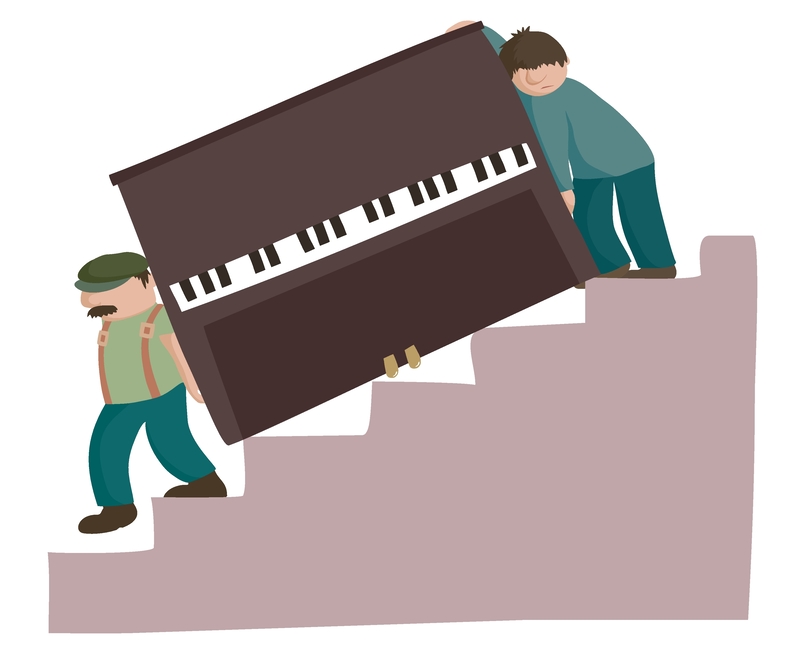Ace the Task of Moving Your Bed and Mattress
Posted on 30/05/2025
Ace the Task of Moving Your Bed and Mattress: The Ultimate Stress-Free Guide
Relocating to a new home is an exciting journey, but certain aspects--like moving your bed and mattress--can become unexpectedly challenging. Whether it's about safeguarding your pricey memory foam, keeping your mattress and bed clean, or simply finding the best way to move a bed set efficiently, this comprehensive guide will equip you with all the knowledge you need to ace the task of moving your bed and mattress successfully.

Why Proper Mattress and Bed Moving Matters
Many people underestimate the importance of moving beds and mattresses correctly. Improper handling can lead to damage, loss of comfort, and even health issues due to contamination. Beds and mattresses are significant investments, and ensuring they arrive at your new destination in great shape is essential for preserving their comfort and your sleep quality.
Common Challenges in Moving Beds and Mattresses
- Awkward shapes and sizes make maneuvering difficult.
- Risk of tears, stains, and damage to mattress fibers.
- Potential for trapped moisture and pests if stored or moved improperly.
- Assembling and disassembling bed frames can be confusing or time-consuming.
- Sore backs and injuries from lifting heavy items incorrectly.
Avoiding these setbacks is possible with the right techniques and equipment. Let's dive into the step-by-step process to make your move smooth and stress-free.
Step-By-Step Guide to Move Your Bed and Mattress Like a Pro
1. Plan Ahead
Preparation is key to acing the task of moving your bed and mattress. Start by measuring all doorways, hallways, and staircases to ensure your bed and mattress will fit through. This avoids problems at the last moment.
- Measure your bed frame and mattress dimensions.
- Check for tight corners that may complicate transportation.
- Prepare a pathway by removing any obstructions.
- Schedule your move for a dry day to avoid moisture damage.
2. Gather Necessary Tools and Supplies
Having the right materials makes the process efficient and secure. Consider the following:
- Mattress bags or covers to protect from dust, bugs, and moisture.
- Furniture blankets for cushioning sharp edges.
- Screwdrivers, Allen wrenches, or power tools for bed frame disassembly.
- Moving straps or furniture sliders to reduce strain and injury.
- Heavy-duty tape and bubble wrap for parts and accessories.
3. Disassemble the Bed Frame
Disassembling the bed frame makes transportation much easier and less risky for both your furniture and your back. Here's how to do it efficiently:
- Remove bedding, pillows, and the mattress first.
- Use appropriate tools to unscrew slats, headboard, and footboard.
- Place all screws, bolts, and small parts in labeled plastic bags. Tape the bag securely to the bed frame parts.
- Wrap wooden pieces in moving blankets or bubble wrap.
- Mark or label each piece if your bed has complex assembly to streamline reassembly later.
4. Prepare Your Mattress for the Move
Mattress care during transportation is vital. Mattresses are prone to collecting dirt and moisture, which can lead to bacteria, mold, or unpleasant smells.
- Vacuum the mattress thoroughly to remove dust and mites.
- Allow it to air out for an hour before packing.
- Encase the mattress in a high-quality, waterproof mattress moving bag or cover. Double-seal the opening with duct tape for extra protection.
Never attempt to fold or bend a spring mattress forcibly; this can cause irreparable damage. If your mattress is designed to fold (some memory foam types), do so only as per manufacturer guidelines.
5. Move the Bed and Mattress with Care
- Carry the mattress with a friend--never attempt this alone for safety reasons.
- Use lifting straps to distribute weight evenly and avoid injury.
- Keep the mattress upright and avoid dragging it along the floor.
- Be mindful of walls and door frames to prevent tears or dents.
If you're dealing with stairs or narrow passages, take it slow. Sometimes, tilting the mattress slightly can make navigation easier.
6. Secure Transport in the Vehicle
Proper loading is crucial to ace the task of mattress moving. Whether you've rented a moving van or hired professional movers:
- Lay the mattress flat in the vehicle to prevent warping--avoid stacking heavy items on top.
- Use straps to secure the mattress and prevent shifting during transit.
- Store bed frame parts separately, protected with blankets or padding.
If you need to use a car roof, double-bag the mattress and secure it tightly with ropes at several points--check local regulations about transporting large items on the roof.
7. Reassemble and Set Up in Your New Home
Once at your new residence, carry out these best practices for a hassle-free setup:
- Unpack the mattress promptly and allow it time to air out before using.
- Assemble the bed frame by following the labels and notes you made during disassembly.
- Tighten all bolts and screws to avoid a squeaky or unstable bed.
- Place the mattress back on the frame, checking for any damages incurred during the move.
- Install a clean mattress protector before adding your bedding.
Tip: Use a level to check that your bed frame is evenly positioned--this will improve both mattress longevity and sleep comfort.
Professional Movers vs. DIY: What's Best For Moving Beds and Mattresses?
Should you move your bed and mattress yourself, or hire professionals? Here are factors to consider:
- Budget - Professional movers cost more but save effort and risk of damage.
- Time - Pros are much faster and come prepared with the right equipment.
- Specialty beds (like adjustable or canopy frames) often demand skilled handling.
- Physical ability - If lifting is a concern, leave heavy lifting to the experts.
- Insurance - Movers often offer coverage in case of damage; DIY relies on your caution.
If you choose DIY, rent a moving vehicle with enough space. For very valuable or bulky furniture, opting for professional help may be a wise investment.
Essential Tips to Ace the Task of Mattress and Bed Moving
Top Hacks for a Flawless Move
- Work in teams: Always enlist help for heavy lifting.
- Wear gloves to protect your hands from nicks and splinters.
- Take photos before disassembling complicated bed frames for easy reassembly.
- Label EVERYTHING--from slats to screws.
- For longer moves, stand the mattress upright to save space, but avoid bending unless specified by the manufacturer.
- Store mattress and bedding in a dry, climate-controlled environment if there's any delay in moving in.
- Don't forget to inspect your mattress for bed bugs before and after moving--use a flashlight and magnifying glass for a close look.
Common Mistakes to Avoid When Moving Beds and Mattresses
- Dragging the mattress across rough surfaces.
- Using regular plastic sheets instead of purpose-made mattress bags.
- Forgetting to tighten bed frame parts, resulting in wobbly beds.
- Leaving bedding on during the move (increases risk of contamination).
- Ignoring manufacturer's care instructions for specialty mattresses.
- Attempting to move large items down steep or winding stairs without a spotter.
Special Considerations for Different Mattress Types
Memory Foam Mattresses
Memory foam is particularly vulnerable to tears and bending. Wrap these mattresses carefully and never store upright for long periods, as this can cause the foam to settle unevenly.
Hybrid or Spring Mattresses
Avoid folding, and keep them as flat as possible during transport. Use sturdy, thick mattress covers for protection.
Pillow Top Mattresses
Pillow tops are prone to compression. Use reinforced covers and avoid pressing heavy boxes or furniture against these mattresses during a move.
Latex Mattresses
Latex is heavy and can stretch if not properly supported. Two or more people should carry latex mattresses, always keeping the mattress flat.
Frequently Asked Questions about Moving Your Bed and Mattress
Is it OK to fold a mattress when moving?
*Only fold mattresses if the manufacturer specifically says it is safe* (sometimes memory foam is foldable). Never fold spring or hybrid mattresses as this can damage the support system.
Should I clean my mattress before moving?
Absolutely! Cleanliness prevents pests and keeps your new bedroom fresh. Vacuum thoroughly, air out, and encase in a mattress bag immediately before moving.
How do I move a heavy bed frame down stairs?
Disassemble as much as possible, clear all obstacles, and use moving straps. At least two people should carry each large piece--take your time and watch your footing.
Can I move a mattress on top of my car?
While it's possible, it's not ideal. If you must, double-bag the mattress and tie with heavy-duty ropes at multiple points. Drive slowly, and remember this may not be allowed in all areas.

Conclusion: Moving Your Bed and Mattress with Confidence
With the right preparation, practical tips, and equipment, you can confidently ace the task of moving your bed and mattress without stress or damage. Protect your investment, enjoy a restful night's sleep from the first night in your new home, and save yourself time, money, and hassle. Whether you're tackling the move alone or enlisting professionals, following this detailed guide ensures your sleep setup arrives safe, sound, and ready to use.
Remember: a smooth move is all about careful planning, the right tools, and a little teamwork. Happy moving!
Related Resources and Further Reading
- How to Clean a Mattress
- Mattress Buying and Moving Guide
- Apartment Therapy: Moving Mattresses and Beds
If you found this guide helpful, share it with others preparing for a move so they, too, can ace the task of moving their bed and mattress!



